There’s something truly mesmerising about a waterfall. The sheer power, the thunderous roar, the mist dancing in the sunlight. It’s nature at its most theatrical. And when it comes to waterfalls, Norway delivers in spectacular style.
This long, mountainous country is home to some of the most dramatic and diverse waterfalls in the world.
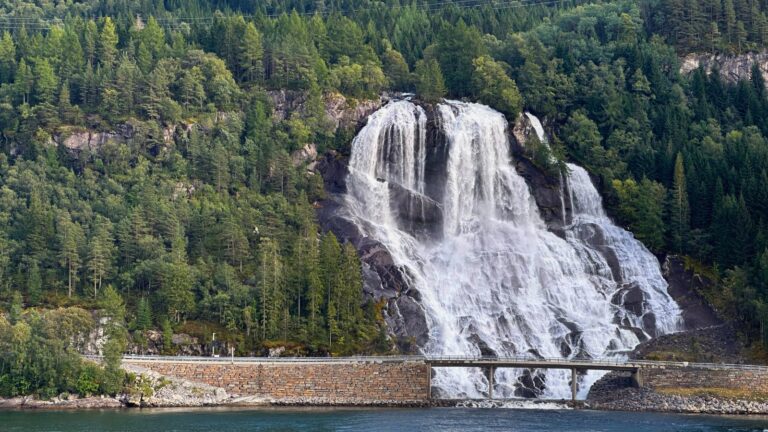
From towering single drops to delicate multi-streamed cascades tumbling down fjord cliffs, Norway’s waterfalls are shaped by its glaciers, snowmelt, and relentless rainfall. They don’t just add beauty to the landscape. They are the landscape.
In fact, waterfalls are such a part of everyday life in Norway that you’ll likely spot dozens just on a scenic drive.
But a few have achieved legendary status, whether because of their sheer size, unique shape, or the myths and stories that surround them. Some are easy to access, while others require a bit of effort, but all are worth the journey.
Whether you’re planning a road trip through the Norwegian fjords, hopping on a sightseeing cruise, or exploring the high mountain passes, keep an eye out for these magnificent natural wonders.
Here are some of the most famous and most photogenic waterfalls in Norway that you won’t want to miss.
The Seven Sisters of the Geirangerfjord
Norway's most famous fjord is also home to arguably its most famous waterfall. Or more accurately, waterfalls.
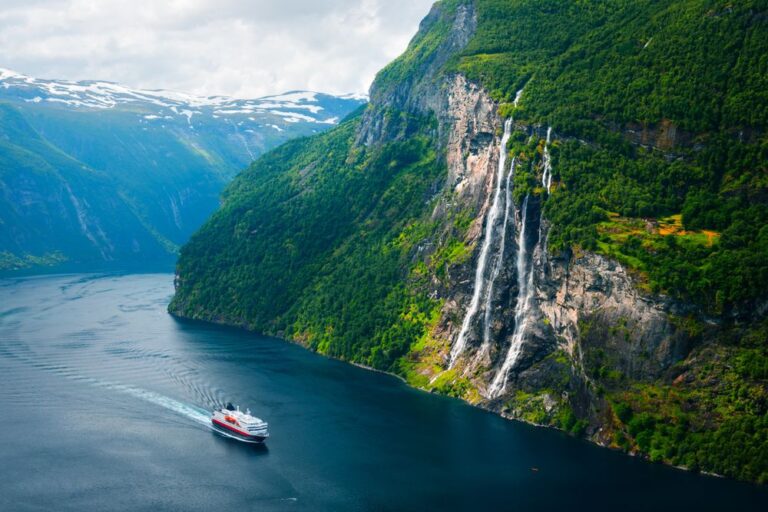
As its name implies, the Seven Sisters (De syv søstrene) is actually seven separate streams of water tumbling down the steep side of the Geirangerfjord.
Most of Norway's waterfalls look different depending on season, none more so than the Seven Sisters. For one thing, there can be more or less than seven waterfalls depending on the time of year and recent weather!
The water falls from a height of 410 meters and includes a free-fall of up to 250 meters on its way down to the fjord. The sight is most often seen on the Geirangerfjord ferry that shuttles camera-wielding tourists between the fjordside villages Geiranger and Hellesylt.
The location is also well known for the abandoned farmsteads visible from the water: Knivsflå and Skageflå were abandoned more than 100 years ago due to the increasing risk of avalanche and falling rocks.
Skageflå achieved fame in 1993 when Norway’s King Harald and Queen Sonja celebrated their silver wedding anniversary at its secluded setting.
Kjosfossen on the Flåm Railway
Kjosfossen might just be the most theatrical waterfall in Norway—and that’s not just because of the waterfall itself. Located along the Flåm Railway, Kjosfossen is a powerful 225-metre cascade that draws thousands of visitors each year.
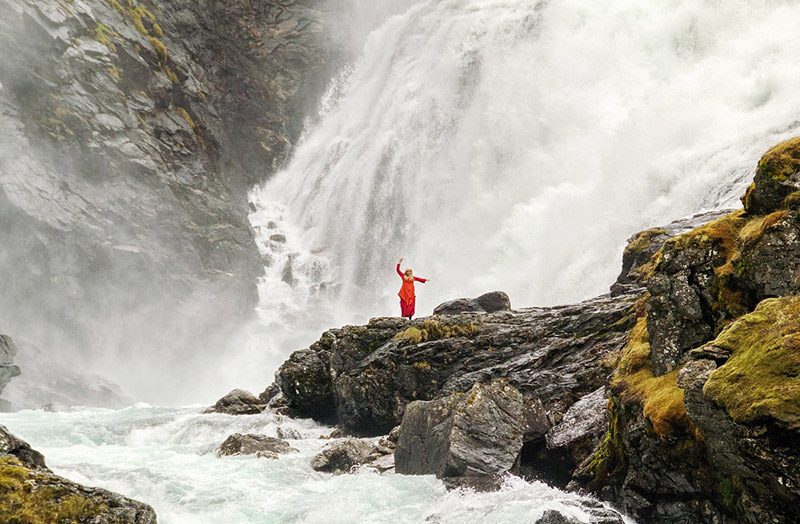
The train makes a dedicated stop to let passengers off for photos and a closer look. During the summer months, there’s even a surprise in store: a performance by a mythical Huldra, the forest spirit of Norwegian folklore, who dances among the rocks to traditional music.
This is no ordinary sideshow. The performance is backed by the Norwegian Ballet School, and the whole experience adds a magical, otherworldly layer to the already unforgettable setting.
Kjosfossen is also a working waterfall: it powers a small hydroelectric plant that helps run the railway itself. How very Norwegian.
Vøringsfossen
Vøringsfossen isn’t just a waterfall. It’s a national icon. With a total drop of 182 metres, this dramatic cascade plunging into the lush Måbødalen valley has been captivating visitors since the 19th century.
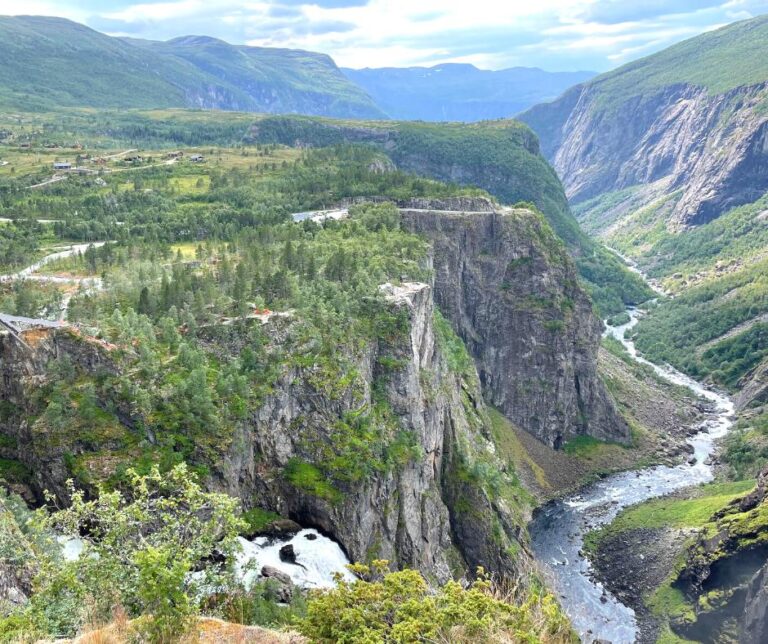
Located just off the scenic Route 7 between Oslo and Bergen, Vøringsfossen is surprisingly easy to access.
A well-maintained car park and viewing area offer quick glimpses of the falls, but for those willing to venture a little further, the rewards are far greater. A network of trails leads to various viewpoints, each offering a different angle on the roaring torrent and the deep gorge it has carved into the landscape.
The newest addition is a spectacular footbridge suspended across the gorge itself. Opened in 2020, this architectural marvel features 99 steps and gives thrill-seekers a bird’s-eye view of the water tumbling beneath their feet. It's not for the faint of heart!
The best time to visit is from late spring through early autumn (May to October), when the trails are open and the waterfall is at its most powerful, fed by melting snow from the Hardangervidda mountain plateau above.
A trip to Vøringsfossen pairs naturally with other highlights of the Hardanger region. Just down the road is the charming fjordside village of Eidfjord, while the dramatic expanse of the Hardangervidda National Park lies just beyond.
You can also easily tie in a visit to nearby Steinsdalsfossen or continue your journey along the Hardangerfjord for more of Norway’s best scenery.
Langfossen
Often overlooked by international travellers, Langfossen is one of Norway’s hidden gems—and one of its most breathtaking.

Located near the Åkrafjord in western Norway, Langfossen tumbles an astonishing 612 metres down a rocky cliff, making it one of the tallest waterfalls in the country.
But it’s not just the height that impresses—it’s the way the water spreads out and cascades in stages down the rugged mountainside, creating a constantly shifting spectacle.
CNN once named Langfossen one of the world’s ten most beautiful waterfalls, and it's easy to see why.
Best of all? You don’t need to hike to see it. The waterfall is right beside the E134 highway, and you can enjoy the view from a scenic lay-by, or hike a short trail for a different perspective.
If you’re exploring southwestern Norway, visiting Haugesund, or passing through Hardangervidda, it’s well worth the detour.
Låtefossen
Few waterfalls in Norway are as effortlessly photogenic as Låtefossen. Located along Route 13 just south of Odda, this dramatic twin cascade drops 165 metres and flows right under a historic six-arched stone bridge.
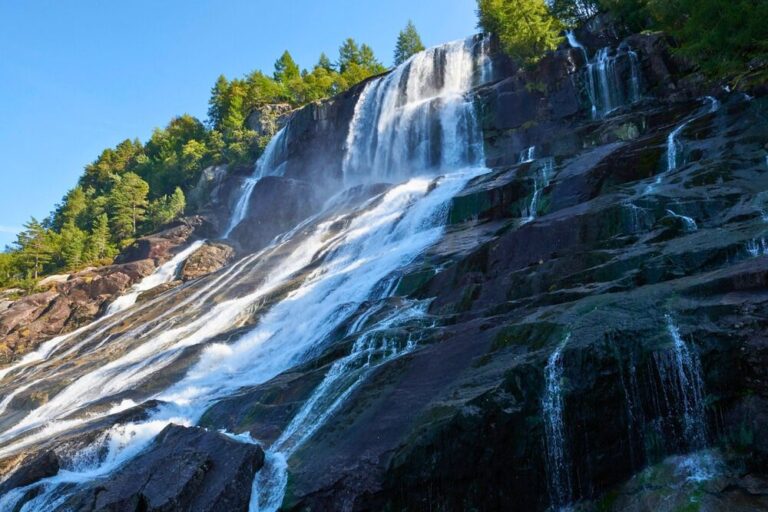
What makes Låtefossen truly unique is that it’s actually two waterfalls side by side, originating from the Lotevatnet lake above.
The streams crash down parallel to each other before merging just above the road, sending spray flying in every direction. You’ll probably need your windscreen wipers even on a sunny day!
There’s a small lay-by just after the bridge where you can stop to take photos or stretch your legs.
No hiking is required, and that accessibility makes it one of the most visited waterfalls in Norway, especially for those exploring the Hardangerfjord region by car. It's a roadside marvel you really shouldn’t miss.
Steinsdalsfossen
At just 46 metres high, Steinsdalsfossen may not break any records, but it delivers one of Norway’s most unique waterfall experiences.
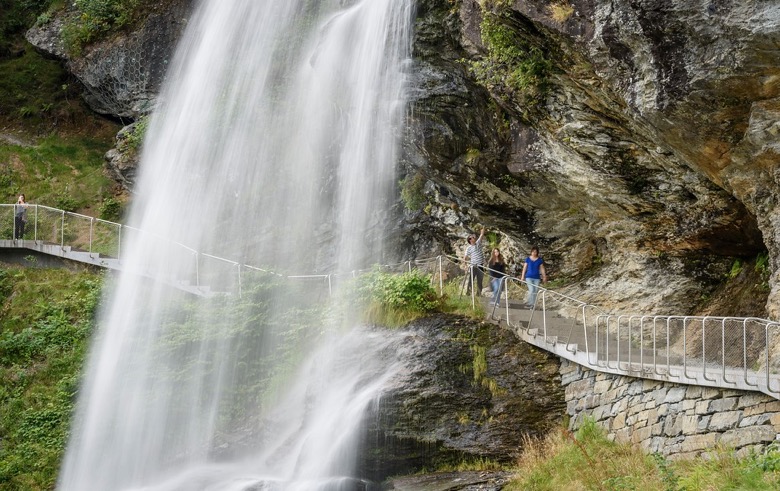
Here, a gently sloping trail leads you behind the waterfall itself, allowing you to stand in a dry tunnel-like space and watch the water crash down just metres away. It’s a rare chance to get up close to the action, without getting soaked.
Located in Norheimsund along the Hardangerfjord, Steinsdalsfossen is easily accessible from Bergen and makes a great stop on a Hardanger day trip.
The waterfall is especially powerful in late spring and early summer, when the snowmelt from the mountains above adds to the flow.
Fun fact: Germany’s Emperor Wilhelm II was so taken with the place that he visited nearly every summer between 1889 and the outbreak of World War I.
Hellesyltfossen
While the nearby Geirangerfjord gets most of the international attention, the village of Hellesylt has a dramatic secret of its own: Hellesyltfossen.
This powerful waterfall roars right through the centre of the village, creating a striking natural divide and an unmistakable soundtrack to everyday life here.
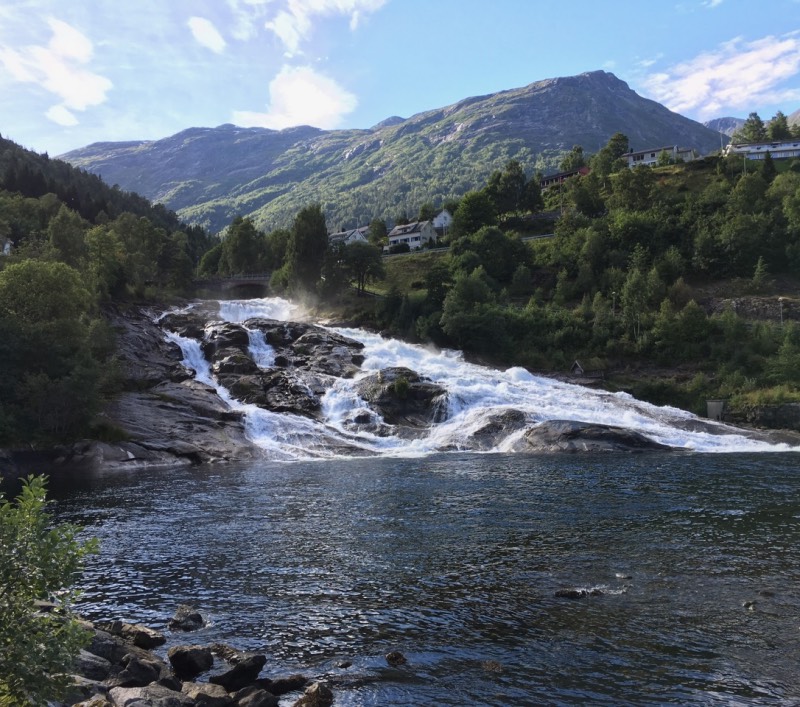
Although just 20 metres high, Hellesyltfossen impresses not with height but with sheer force.
The volume of water crashing through the rocky gorge is particularly dramatic in spring and early summer, when melting snow from the mountains above turns the falls into a white-water torrent. At peak flow, it’s hard to believe such power is hiding in a sleepy fjordside village.
A steep walking path climbs alongside the waterfall, leading to a charming old stone bridge with the best panoramic view of the cascade below and the village rooftops beyond.
The combination of rushing water, historic buildings, and sheer granite rock makes it a dream for photographers, especially in the golden evening light.
The falls are easy to enjoy even if you’re just passing through. Hellesylt is the departure point for the popular ferry crossing to Geiranger, and the waterfall is just a few steps from the ferry dock, making it one of the most accessible natural attractions in the area.
If you have a little more time, Hellesylt is also a gateway to the scenic Norangsdalen valley and the hidden gems of Sunnmøre, making it a worthwhile stop on any Western Norway itinerary.
Stigfossen at Trollstigen
One of Norway's most dramatic waterfalls comes with an equally dramatic approach. Stigfossen is a 300-metre cascade that thunders down the mountainside beside the legendary Trollstigen mountain pass, part of route 63, a national scenic route.
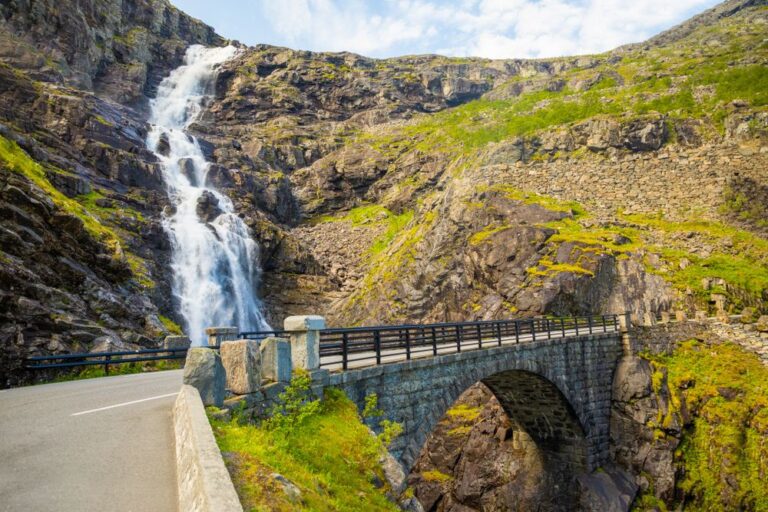
As you wind your way up the steep mountainside, negotiating 11 tight hairpin bends, Stigfossen appears like a constant companion. Its white spray gleams against the dark rock and its roar echoes through the valley.
The waterfall tumbles beneath an old stone bridge, now one of the most photographed spots along the route. If you can pull into one of the passing bays safely, it’s worth hopping out to admire the view and feel the mist in the air.
But unlike many waterfalls on this list, the real magic of Stigfossen is tied to its surroundings. Trollstigen isn’t just about the waterfall. At the summit, you’ll find a modern visitor centre with toilets, a café, and walkways leading to breathtaking viewing platforms perched above the road and waterfall.
From here, you can gaze down at the twisting road you just climbed, with Stigfossen crashing down beside it and the dramatic Isterdalen valley stretching into the distance.
Visit early in the morning or late in the evening to avoid the long lines of tour buses and motorhomes that inch their way up the pass during peak hours. And if you’re feeling adventurous, you might even spot a few cyclists tackling the climb. Yes, really!
Tvindefossen
Just outside the adventure town of Voss lies Tvindefossen, a 110-metre-high waterfall beloved for its layered, ribbon-like appearance.
Here, the water fans out into dozens of streams as it tumbles down a broad rock face, creating a veil-like effect that makes it a favourite among photographers.
Despite its size, it’s an easy hike to the base and even up the side—where you’ll be rewarded with a different perspective and, in good conditions, a bonus smaller waterfall.
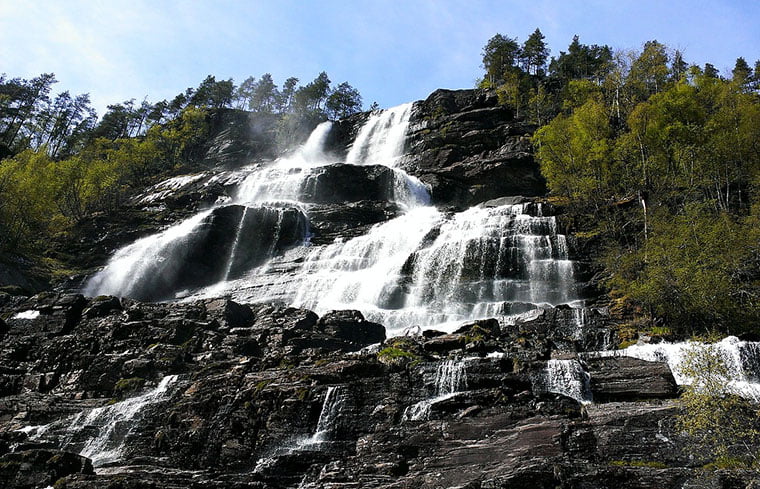
Tvindefossen is an ideal stop if you’re exploring Voss or travelling between Bergen and the Sognefjord region.
Vermafossen
Set deep in the dramatic Romsdalen valley, Vermafossen is a striking 380-metre waterfall that surges down the mountainside near the village of Verma, along the scenic E136 route between Åndalsnes and Dombås.
The waterfall itself is impressive, but what makes this stop truly memorable is the combination of nature and engineering. Just downstream from the cascade is Kylling Bridge, a stunning arched stone railway bridge that spans the river 60 metres above the gorge.
Built in the early 20th century, the bridge carries the scenic Rauma Line and is often captured in dramatic photographs with a train crossing above the rushing water.
There’s a signposted lay-by and a small kiosk open during the summer months, making it a worthwhile stop for road-trippers. A short walk from the car park brings you to a viewpoint with a picture-perfect angle of both the waterfall and the bridge.
Just be cautious. The spray from the waterfall can make the rocks and paths slippery, especially after rain. It’s a peaceful, awe-inspiring spot to stretch your legs and take in one of the region’s quieter, yet most photogenic, natural landmarks.
Ramnefjellsfossen
With a total drop of 818 metres, Ramnefjellsfossen (also known as Utigardsfossen) is one of the tallest waterfalls in the world, yet it remains one of Norway’s most tranquil and underrated natural wonders.
Located near the serene Lovatnet lake in Nordfjord, the waterfall flows from the glacier-fed Ramnefjellbreen, a branch of the mighty Jostedalsbreen glacier.
While the volume of water isn’t particularly high, the long, narrow stream cascading down the mountainside is captivating in its elegance, and the setting couldn’t be more peaceful.
A boat ride or kayak tour on the turquoise waters of Lovatnet offers stunning views of the falls from below. You can also hike toward the base of the waterfall, or simply enjoy the view from the lakeside road.
Its quiet beauty and remote setting make Ramnefjellsfossen ideal for travellers who prefer serenity over crowds. Plus, the nearby Briksdalsbreen glacier and Loen skylift make this area well worth a longer stay.
Furebergfossen
Tucked along the scenic route between Rosendal and Odda, Furebergfossen is one of those waterfalls that makes you pull the car over, no matter how tight the itinerary.
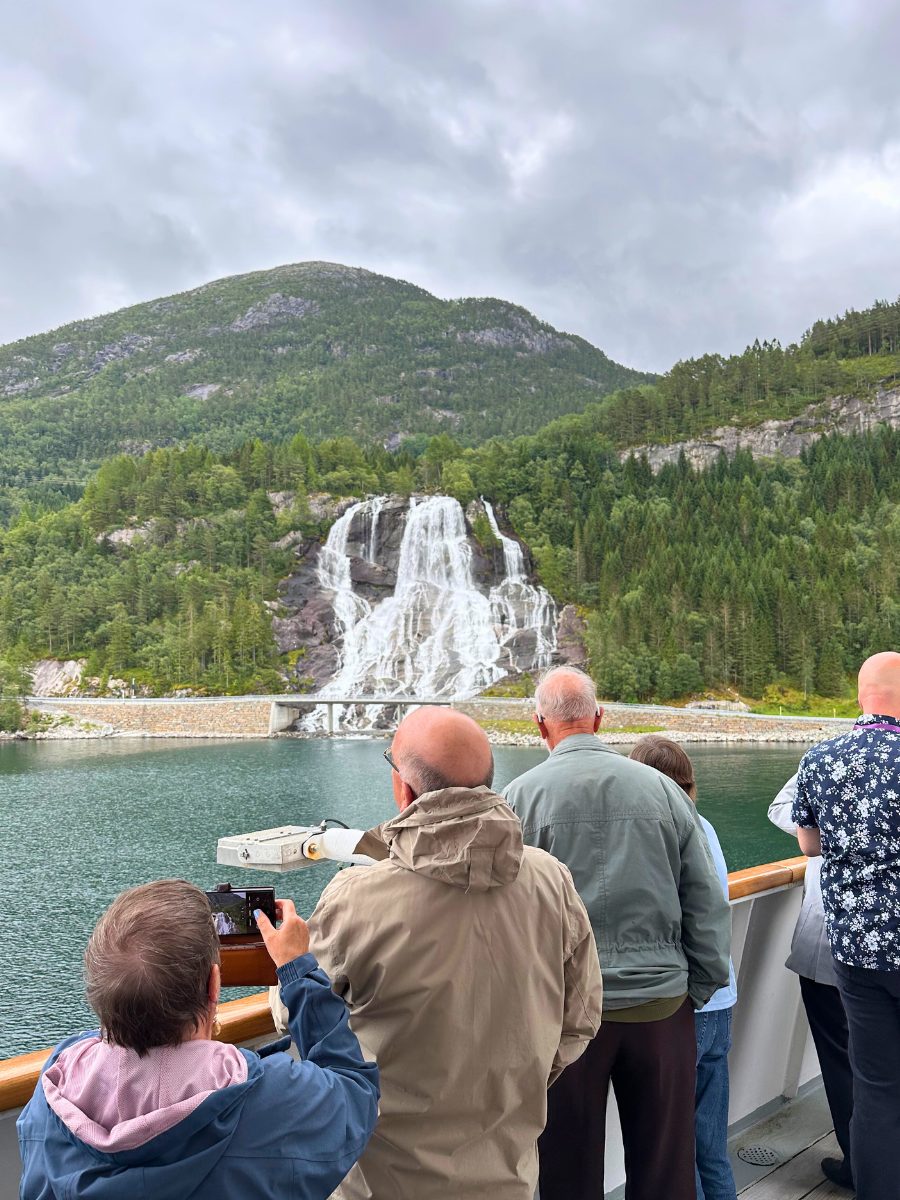
It’s not just the height or power of the fall (though both are impressive!) but the way it crashes almost theatrically down the mountainside, right beside the road. There’s no long hike and no entrance fee, just a raw, untamed torrent that seems to erupt straight out of the rocks.
On rainy days or during spring melt, the spray is so strong you might need your windscreen wipers even when parked.
The waterfall tumbles into the Maurangsfjorden, adding a dramatic soundtrack to one of Norway’s lesser-known fjord arms. I was lucky enough to see the waterfall from Fred Olsen's Balmoral last year and it brought the whole ship out to the open decks to gaze in wonder.
Furebergfossen might not be the most famous name in Norway’s waterfall hall of fame, but it leaves a lasting impression on anyone lucky enough to pass by.
So there you have it. While far from an exhaustive list of Norway's best waterfalls, these are my personal favourites. What about you?
If you enjoyed this post as much as I enjoyed making it, why not share it on Pinterest so others can get inspired to visit? There's a pin for that. Just hit those social sharing buttons.

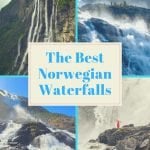

Simply stunning photographs and I am so looking forward to my cruise round Norway for 17 days starting next week up to Alta. Thank you.